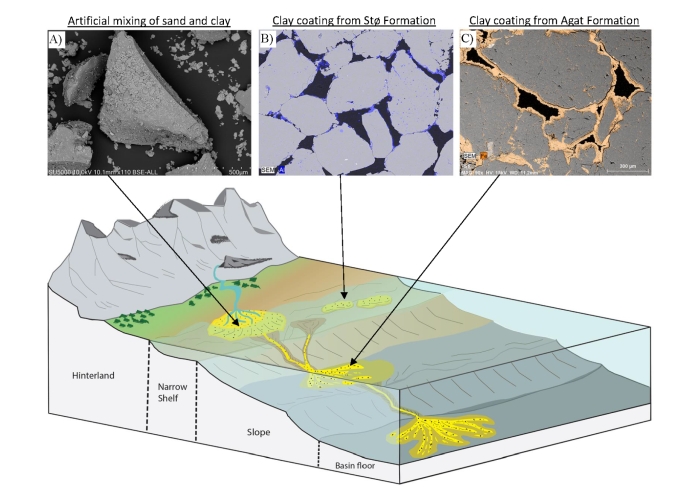The PhD defence and trial lecture will be held in Auditorium 1, The Geology Building.
Trial lecture
Wednesday 7 December, 10:15-11:00, Aud 1, The Geology Building:
Sedimentary and stratigraphic heterogeneity in coastal depositional systems with a focus on clay drapes and primary clay coating mineral distributions
Conferral summary (in Norwegian)
Petroleumsindustrien har stadig større fokus på å drive kostnads- og miljøeffektiv letepolitikk, og et viktig ledd i denne strategien er å bruke eksisterende infrastruktur. Dette medfører at letevirksomheten i større grad konsentreres mot dypere begravde sandsteinsreservoarer. Reservoarkvalitet i sandsteiner reduseres gjerne betraktelig som en funksjon av økende dybde (> 2.5 km) om det ikke er en porøsitets- og permeabilitetsbevarende mekanisme tilstede. Dette doktorgradsarbeidet benytter ulike datasett og metoder for å undersøke dannelse, distribusjon, effekt og forutsigbarhet av leirbelegg på sandkorn i sandsteiner som en mekanisme for bevare gode reservoaregenskaper i dypt begravde sandsteiner. Avhandlingen presenter resultater som kan ha stor betydning for en effektiv letepolitikk.
Main research findings
Popular scientific article about Hansen’s dissertation:
Reservoir quality characterization and prediction of deeply buried clay coated sandstones on the NCS, Examples from the South Western Barents Sea and Northern North Sea
In recent years, petroleum exploration that utilizes existing infrastructure to save time, cost and lower production related C02 emissions have become more important. This strategy require more emphasis on deeply buried prospects which call for a thorough understanding of geological processes that affect reservoir quality distribution in deeper parts (> 2.5 km) of the subsurface. This doctoral work focuses on the characterization of clay coats in reservoir sandstones, a feature important for persevering high reservoir quality in deeply buried reservoirs. The objectives are to enhance our understanding of their distribution, formation and implications for reservoir quality heterogeneity.
The main findings of this doctoral study include:
- The morphological characteristics of clay coats have important implications for reservoir quality heterogeneity.
- Historical core- and well log data in conjunction with machine learning can effectively aid regional reservoir quality delineation.
- Simple lab experiments can be key to unlock the controls on how clay coats form on the surface of sand grains. Results from this doctoral study indicate that specific physical- and chemical processes between sand and clay particles control the clay attachment process.

Photo and other information:
Press photo: Henrik Nygaard Hansen, portrait; 400px. Photo: Private
Other photo material: Figure with description and credit as specified in the article above, size 1860px.
